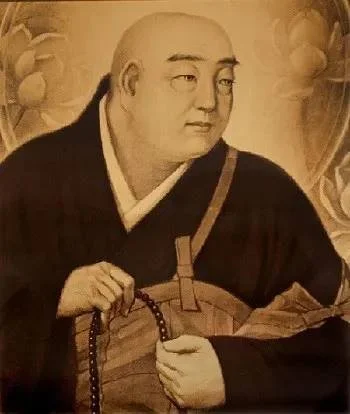Shinran’s Joy of Embracing the Pure Land Teachings
The logo represents the light of lamp that symbolizes Shinran Shonin’s life. The logo is also a stylized lotus flower with people sitting around Shinran Shonin.
Celebrating the 850th Year of Shinran Shonin’s Birth and 800th Year of Establishment of Jodo Shinshu (Shin Buddhim) – Part 1/3 -
This May, in celebration of founder Shinran Shonin’s 850th birthday and the 800th anniversary of the establishment of Jodo Shinshu—called Shin Buddhism in the West—I will contribute articles focusing on Shinran’s important life events leading up to the May issue. This month’s article describes Shinran’s dramatic encounter with Pure Land Buddhism and his teacher Honen.
The Religious Landscape in Honen’s Time
Of all the religious currents in Kamakura Buddhism (Kamakura period 1185 – 1333 C.E.), the Pure Land movement was the most pervasive. The period is known for the emergence of local samurai and warriors who formed feudalism in Japan. Political unrest and natural disasters brought confusion and fear to ordinary people, who yearned for a path to peace and harmony. Honen (1133 – 1212 C.E.) stood as Pure Land’s foremost advocate. Religious practice on Mt. Hiei was ultimately geared to the cleric and was predicated on the idea that the priest is superior to the lay person in spiritual advancement.
Hōnen
Honen’s Teaching
Honen began to reassess the value of clergy while still on Mt. Hiei. After reading the Kuan ching shu (Commentary on the Pure Land Meditation Sutra) composed by the Chinese Pure Land mater Shan-tao (613 – 681 C.E.), he departed from Mt. Hiei for the Yoshimizu area in Kyoto and exclusively preached the Nembutsu to visitors of walks of life as a path to spiritual liberation in Amida’s realm of nirvana. Honen’s Pure Land teaching sounded accessible and widely appreciated by the people, Shinran among them.
Honen Shonin e-den (Illustrated Biography of Master Honen),
Honen interpreted the Nembutsu in a much broader context than the traditional schools of Buddhism (called Nara Buddhism). In Honen’s Senjaku-hongan-nembutsushu (Passages on the Nembutsu Selected in the Primal Vow), he urged that anyone who desires to escape quickly from the cycle of birth and death should choose: 1) to enter the gate of Pure Land rather than the holy path; 2) right practices rather than miscellaneous practices; and 3) the act of uttering the Name of Amida Buddha exclusively. Those who utter the Name will unfailingly attain rebirth because it is based on Amida’s Universal Vow.
Dim Light as Hope
Shinran first visited Honen at his Yoshimizu school after having the revelation in a dream at the Rokkaku temple during dawn of the 95th day of 100th day visitation. Honen was then close to 70 years of age. Shinran visited Honen day after day to hear the Amida Buddha’s teaching and the way to transcend the cycle of birth and death in this life.
Regardless of our ignorance and the evil acts we have committed, if we recite the Buddha's Name with total trust in the Buddha’s Vow to enlighten all sentient beings, we will awaken in the Buddha’s realm. That is why it is referred to as the ‘easy path.’ This Honen’s simple teaching touched Shinran’s heart and mind, and eventually led Shinran away from Mt. Hiei and the monastic practices.
After several years as Honen’s disciple, in 1201 Shinran finally discarded sundry practices and took refuge in the Primal Vow, which signified his great turning point. Subsequently, in 1205, Master Honen allowed Shinran to copy his Passages on the Nembutsu Selected in the Primal Vow and his own portrait, and Honen signed Shinran’s name on the copy. Honen was seventy-three years old. Shinran must have been in deep joy to have realized the efficacy of Amida’s universal vow through meeting Honen. More than twenty-years of his monastic path finally ended while a new path opened up toward the gate of Pure Land. Shinran finally saw a light of hope at the end of long tunnel.
Opposition to the Nembutsu
Honen’s revolutionary interpretation of Pure Land Buddhism soon evoked a harsh reaction from other Buddhist schools particularly the Tendai school. While Honen’s teaching was getting tremendously popular, in 1204 he issued the Seven Article Pledge, called Shichikajo kishomon, which is the rules of conduct to have his followers obey. Consequently, Gedatsubo-Jokei of Hosso school (one of the Nara Buddhist Schools) imposed the nine accusations in 1205 toward Honen’s teaching. By 1207, this led to the prohibition of the exclusive Nembutsu, the exile of Honen and Shinran from Kyoto, and the execution of a number of Honen’s followers.
Fortunately, this was not the end of Honen’s and Shinran’s evolution of Pure Land Buddhism. The next issue will talk about the place of exile and Shinran’s propagation in Kanto-Ibaraki area.
Namo Amida Butsu,
Rev. Dr. Mutsumi Wondra



